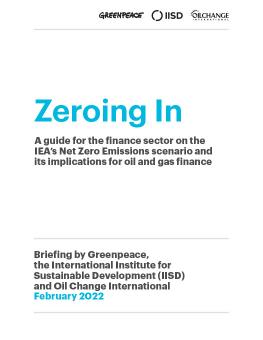
Zeroing In: A guide for the finance sector on the International Energy Agency’s Net Zero Emissions scenario and its implications for oil and gas finance
This briefing aims to give financial institutions an overview of the International Energy Agency’s Net Zero Emissions scenario and what it means for corporate, investor and lender capital allocation decisions and engagement, especially in oil and gas. The IEA drew the headline conclusion that keeping warming to 1.5C leaves no room for new oil & gas development worldwide. This briefing finds that that conclusion is implied by other 1.5C pathways, including those published by the IPCC.
-
IPCC 1.5C scenarios imply no room for new oil and gas development, echoing the @IEA's Net Zero scenario.
-
Global oil and gas production must decline by about 3-4% per year to limit global warming to 1.5C; this leaves no room for new oil or gas fields to be developed after 2021.
-
The finance sector can play an essential role in ensuring oil and gas company investments are aligned with the Paris goals; the IEA’s Net Zero scenario provides a new minimum standard to guide decision making.
In 2021, the International Energy Agency (IEA) published its first guide on how the world’s energy system would look if global warming is limited to 1.5°C. The IEA’s Net Zero Emissions by 2050 (NZE) scenario made headlines with the finding that oil and gas in already-producing or under-development fields will be sufficient to meet demand: there is no need for any new oil or gas fields to be developed after 2021 in a to 1.5°C world.
The conclusion that there is no need to develop new oil and gas fields follows from the arithmetic of 1.5°C, not from the IEA’s modelling choices. Oil and gas fields commonly produce for 15 or 20 years—and in some cases more. Over their life spans, fields’ rates of production decline as extraction reduces reservoir pressures, even with ongoing investment in those fields. For conventional fields, this decline is on average about 4% per year. Historically, the oil and gas industry has continually developed new fields in order to sustain and grow total production. However, limiting warming to 1.5°C requires oil and gas consumption to fall by around 3%–5% per year. This is why the IEA concludes that no new fields are needed: in a 1.5°C world, oil and gas consumption will decline at roughly the same rate as production from existing fields. This rate of decline is seen in other 1.5°C scenarios, including those published by the Intergovernmental Panel on Climate Change.
While the IEA makes the conclusion about new oil and gas development explicit, the same conclusion is implicit in all 1.5°C scenarios that do not have to offset emissions by relying on an implausible amount of future reliance on carbon dioxide removal by unproven technologies and/or by massive conversion of land to forests and plantations.
The IEA’s NZE scenario is, if anything, conservative on the pace of fossil fuel phase-out. While the NZE’s reliance on carbon dioxide removal is fairly modest compared to other scenarios, it boldly makes use of carbon capture and storage (CCS) to capture emissions from fossil fuel combustion. The NZE would require 800 average-sized CCS plants to be operating worldwide by 2030, which would require building two plants every week between now and 2030. After 30 years of attempts to commercialize CCS, its costs have remained high compared to expectations, and only 27 commercial-scale plants exist worldwide. Avoiding the uncertainties related to CCS would require a faster phase-out of fossil fuels, including early closure of some existing oil and gas fields.
This briefing explains in simple terms what the IEA’s finding means and why the IEA reached its conclusion, with comparisons to scenarios published by the Intergovernmental Panel on Climate Change. The briefing gives guidance to financial actors such as investors, banks, and insurers on how to incorporate the IEA’s findings into their decision making.
Participating experts
You might also be interested in
Carbon Minefields: Oil and gas exploration surging to pre-Covid levels
Oil and gas exploration is booming despite an agreement at last year’s COP 28 climate summit to transition away from fossil fuels.
July Edition | Carbon Minefields Oil and Gas Exploration Monitor
In June 2024, six governments issued 18 oil and gas exploration licences with embodied emissions of 14.7 MtCO2, led by Russia and China.
Border Carbon Adjustments: Trinidad and Tobago country report
This report consolidates, analyzes, and presents views and perspectives of stakeholders from Trinidad and Tobago on border carbon adjustment (BCA) schemes to contribute to the global debate on BCA good practices.
Global Dialogue on Border Carbon Adjustments: The case of Brazil
This report consolidates, analyzes, and presents the views and perspectives of stakeholders from Brazil on border carbon adjustment (BCA) schemes to contribute to the global debate on BCA good practices.